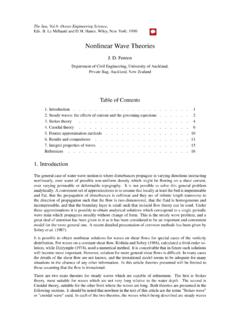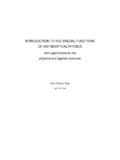Transcription of ISOLATION OF TORSIONAL VIBRATIONS IN ROTATING …
1 National Conference on Power Transmission, 1975 ISOLATION OF TORSIONAL VIBRATIONS IN ROTATING MACHINERY F. R. SZENASI, P. E. Senior Research Engineer L. E. BLODGETT Senior Research Physicist Engineering Dynamics Inc. San Antonio, TX ABSTRACT TORSIONAL vibration response of ROTATING machinery must be determiced when designing an equipment train. Accu- rate response predicti~n rsquires sophisticatsd analysis techniques which include considertion of all forcing functions in the system in addition to the mass -elastic propertiea of the shafts snd eouplisgs. Matrix methods utilizing the eigenvalue solution provide an qdequate solution technique.
2 A proper understanding of the assumptions related to the solution technique is essen- tial. Such areas as lumping, branched system inter- pretation, gear tooth flexibility, and coupling para- meters are but a few examples where assumptions must be made which are essential to a proper solution. ISOLATION of tcrional VIBRATIONS can be acconqli4hed once the system TORSIONAL response is properly defined. Case histories utilizing this technique are presented to illustrate methods of TORSIONAL ISOLATION . INTRODUCTION + TORSIONAL vibration problasts are being encountered in an ever increasing numher due to the expanded use of high speed rotary equipment.
3 These problems are difficult to recognize in their primary stages, and many times they first manifest themselves when a failure occurs. Typically, this type of failure results in a substantial penalty in terms of plant downtime, involving first an analysis of the source of the problem, and then the definition and implementation of a suitable treatment. To diagnose and minimize the occurrence of possible failures due to TORSIONAL vibration , several types of analysis may be employed. The object of this paper is to present the most practi- cal and accurate method for calculating both the tor- sional resonant frequency and the forced vibration re- sponse.
4 With such analyses, stress levels can be cal- culated and compared to a failure criterion. In addi- tion, this gaper presents one method which has been successfully used to evaluate the effect of gear stiff- ness on TORSIONAL response. Although gear stiffness is often neglected or improperly simulated in some in- stances, field experience shows its effect are often critical. Case histories are included to give example data and to illustrate how a forced vibration analysis can be used to predict equipment reliability or to aid in failure solution. HOLZER ANALYSIS The method most commonly employed to calculate the tor- sional resonant frequency of shafting systems is the Holzer Analysis, chiefly because it is conveniently adaptable to hand calculations.
5 The method requires successive estimates of the shaft resonant frequency as input, and it is possible to overlook solutions if the selected frequency increment is too large. The Holzer tabulation method is useful for a cursory check of most shaft systems; however, it becomes quite cumbersome and tedious when a forced vibration response of complex sys- tems is required. Forced vibration problems can be made with the Holzer Analysis; however, this method does not account fcr the phese of the forcing torques in a cam- plex forcing function; therefor , an error can exist. This error is slight for relatively ccnstant torque machines; however, in reciprccating compressors and in- ternal combustian ezgines, the torque is decidedly unsteady dae to piston stroke, and substantial errors can therefore be incurred.
6 Another limitation cf the Holzer W-alysis is the in- ability to properly simulate multiple branced geared systems. The dynamically equivalent system presupposes that the gear assembly is torsionally rigid, which is approximately with generous the case in larse industrial gear boxes factors of safety. For less conservative- ly designed systems, gear tooth flexibility has a defi- nite influence on the TORSIONAL frequencies and should be considered. EIGENVECTOR - EIGENVALUE MATRIX SOLUTION A more powerful and versatile method for solving TORSIONAL resonant frequencies is the eigenvector-eigenvalue matrix solution.
7 While this method insures the calculation of all the possible modes 05 vibration , it requires the use of a digital computer as the computations are numerous and complex. To calculate the tarsional resonant fre- quencies of a system, a mathematical model must be syn- thesized, which will respond in the same manner as the actual system. All of the elastic, mass and damping properties of the system are necessary to set up the mathematical model. Usually, these elastic properties and the masss inertia can be calculated, measured or ob- tained from the manufacturer of the element.
8 Sample differential equations of motion have been written and &re included in Table I. These differential equa- tions can be converted into a matrix equation for sim- plicity of solution, and the general form of the equation would be : where [Jl is the diagonalized mass matrix and [K] is the stiffness matrix. These matrixes are shown in Table 11. Complex periodic motion may be reduced to individual harmonics which can be handled easier without compro- mising the rigorousness of the solution. The equation for simple harmonic motion can then be assumed for the general solution.]
9 0 = A sin at The following relationship for '6 can be obtained by differentiation 8 = Aw cos wt 3 = -~w2 sin ot -4 = -0 2 By substitution, the matrix equation can be rewritten L where the [w ] represents the diagonalized eigenvalue matrix which will be called [I ] . This yields: By multiplying both sides of the matrix equation by [ J] l, the following equation results: and This form of the matrix is the eigenvalue equation. The values for [A] for which the equation is soluble are known as the characteristic values, or eigenvalues, of the matrix. The vector so utions for fe] are the eigen- vectors of the matrix [JI-' IK1 which shall be referred to as the stiffness-mass natrix.
10 Physically, the eigenvector represents the mode shape of the vibration , The corresponding eigenvalue represents the vibrational frequency squared. In general, the characteristic equation will have "nu roots with "nu corresponding eigenvectors for a system with nnn ROTATING masses. The solution for the eigenvalues of a problem with five masses will be a fifth order equation whose solution will give five roots of the characteristic equation. Each of these five roots will then represent a resonant frequency squared. The characteristic equation of this example is as follows: (where A, B.)











